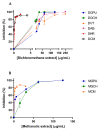Plant Extracts and Phytochemicals from the Asteraceae Family with Antiviral Properties
- PMID: 38398567
- PMCID: PMC10891539
- DOI: 10.3390/molecules29040814
Plant Extracts and Phytochemicals from the Asteraceae Family with Antiviral Properties
Abstract
Asteraceae (Compositae), commonly known as the sunflower family, is one of the largest plant families in the world and includes several species with pharmacological properties. In the search for new antiviral candidates, an in vitro screening against dengue virus (DENV) was performed on a series of dichloromethane and methanolic extracts prepared from six Asteraceae species, including Acmella bellidioides, Campuloclinium macrocephalum, Grindelia pulchella, Grindelia chiloensis, Helenium radiatum, and Viguiera tuberosa, along with pure phytochemicals isolated from Asteraceae: mikanolide (1), eupatoriopicrin (2), eupahakonenin B (3), minimolide (4), estafietin (5), 2-oxo-8-deoxyligustrin (6), santhemoidin C (7), euparin (8), jaceidin (9), nepetin (10), jaceosidin (11), eryodictiol (12), eupatorin (13), and 5-demethylsinensetin (14). Results showed that the dichloromethane extracts of C. macrocephalum and H. radiatum and the methanolic extracts prepared from C. macrocephalum and G. pulchella were highly active and selective against DENV-2, affording EC50 values of 0.11, 0.15, 1.80, and 3.85 µg/mL, respectively, and SIs of 171.0, 18.8, >17.36, and 64.9, respectively. From the pool of phytochemicals tested, compounds 6, 7, and 8 stand out as the most active (EC50 = 3.7, 3.1, and 6.8 µM, respectively; SI = 5.9, 6.7, and >73.4, respectively). These results demonstrate that Asteraceae species and their chemical constituents represent valuable sources of new antiviral molecules.
Keywords: Asteraceae; antiviral; dengue; flavonoids; phenolic compounds; plant extract; sesquiterpene lactones; terpenoids.
Conflict of interest statement
The authors declare no conflicts of interest.
Figures






Similar articles
-
Trypanocidal Activity of Four Sesquiterpene Lactones Isolated from Asteraceae Species.Molecules. 2020 Apr 25;25(9):2014. doi: 10.3390/molecules25092014. Molecules. 2020. PMID: 32344932 Free PMC article.
-
Cytotoxic sesquiterpene lactones from Campuloclinium macrocephalum (=Eupatorium macrocephalum).Phytochemistry. 2020 Nov;179:112469. doi: 10.1016/j.phytochem.2020.112469. Epub 2020 Aug 14. Phytochemistry. 2020. PMID: 32805622
-
Urease inhibitory potential of extracts and active phytochemicals of Hypochaeris radicata (Asteraceae).Nat Prod Res. 2020 Feb;34(4):553-557. doi: 10.1080/14786419.2018.1489387. Epub 2018 Oct 15. Nat Prod Res. 2020. PMID: 30317858
-
[Research progress on sesquiterpenes and its pharmacological activities in genus Carpesium].Zhongguo Zhong Yao Za Zhi. 2020 Jan;45(1):37-51. doi: 10.19540/j.cnki.cjcmm.20190929.201. Zhongguo Zhong Yao Za Zhi. 2020. PMID: 32237409 Review. Chinese.
-
Ethnomedicinal uses, phytochemistry, and biological activities of plants of the genus Gynura.J Ethnopharmacol. 2021 May 10;271:113834. doi: 10.1016/j.jep.2021.113834. Epub 2021 Jan 16. J Ethnopharmacol. 2021. PMID: 33465439 Review.
Cited by
-
The Influence of Solvent Choice on the Extraction of Bioactive Compounds from Asteraceae: A Comparative Review.Foods. 2024 Oct 2;13(19):3151. doi: 10.3390/foods13193151. Foods. 2024. PMID: 39410186 Free PMC article. Review.
-
Comparative Study on Antioxidant Capacity of Diverse Food Matrices: Applicability, Suitability and Inter-Correlation of Multiple Assays to Assess Polyphenol and Antioxidant Status.Antioxidants (Basel). 2025 Mar 6;14(3):317. doi: 10.3390/antiox14030317. Antioxidants (Basel). 2025. PMID: 40227337 Free PMC article.
-
Extracts and Terpenoids from Stevia Species as Potential Anthelmintics for Neglected Tropical Diseases Caused by Cestode Parasites.Molecules. 2024 Sep 18;29(18):4430. doi: 10.3390/molecules29184430. Molecules. 2024. PMID: 39339424 Free PMC article.
References
-
- Dengue and Severe Dengue. [(accessed on 26 July 2023)]. Available online: https://www.who.int/news-room/fact-sheets/detail/dengue-and-severe-dengue.
-
- Dengue—OPS/OMS | Organización Panamericana de La Salud. [(accessed on 26 July 2023)]. Available online: https://www.paho.org/es/temas/dengue.
MeSH terms
Substances
Grants and funding
LinkOut - more resources
Full Text Sources

